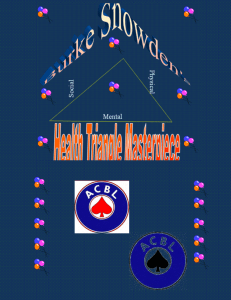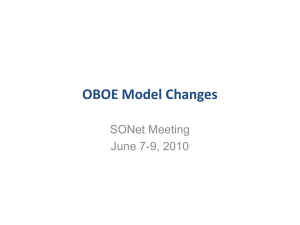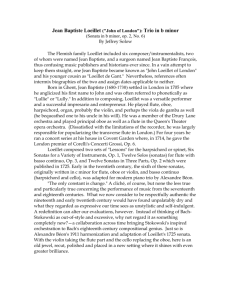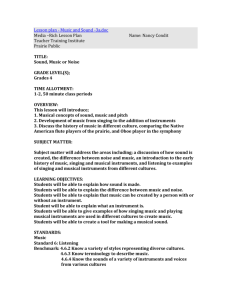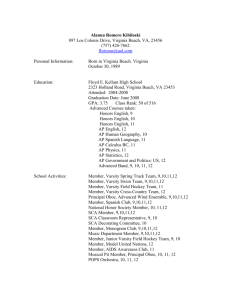Transcript for "The Making of a Masterpiece: Is it possible?"
advertisement
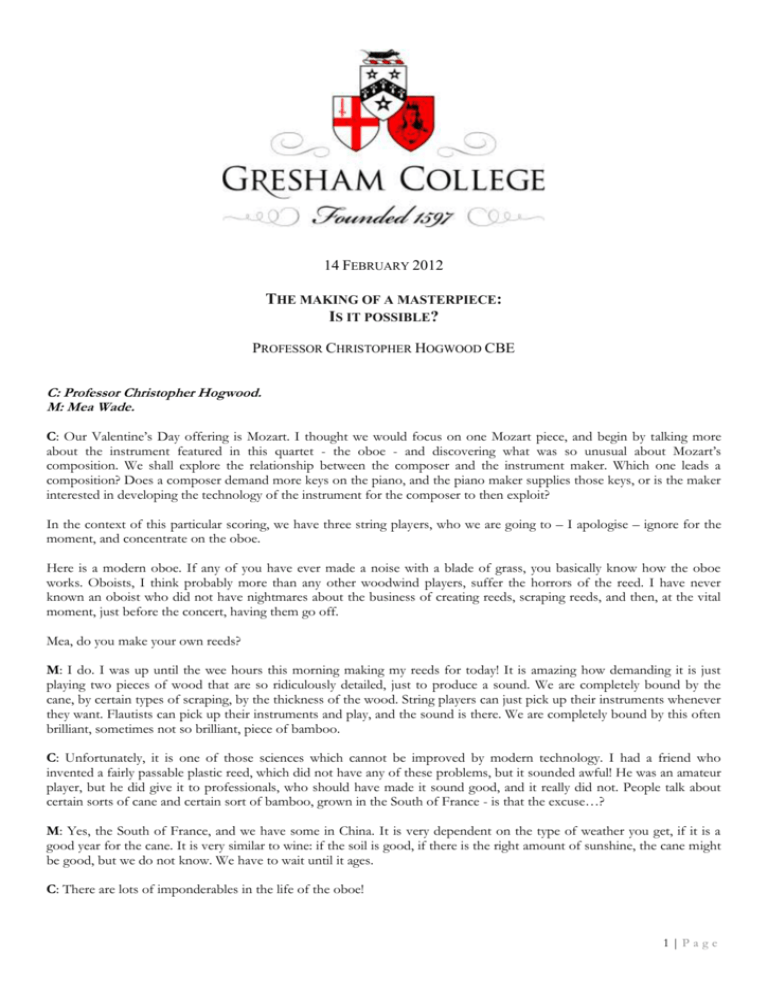
14 FEBRUARY 2012 THE MAKING OF A MASTERPIECE: IS IT POSSIBLE? PROFESSOR CHRISTOPHER HOGWOOD CBE C: Professor Christopher Hogwood. M: Mea Wade. C: Our Valentine’s Day offering is Mozart. I thought we would focus on one Mozart piece, and begin by talking more about the instrument featured in this quartet - the oboe - and discovering what was so unusual about Mozart’s composition. We shall explore the relationship between the composer and the instrument maker. Which one leads a composition? Does a composer demand more keys on the piano, and the piano maker supplies those keys, or is the maker interested in developing the technology of the instrument for the composer to then exploit? In the context of this particular scoring, we have three string players, who we are going to – I apologise – ignore for the moment, and concentrate on the oboe. Here is a modern oboe. If any of you have ever made a noise with a blade of grass, you basically know how the oboe works. Oboists, I think probably more than any other woodwind players, suffer the horrors of the reed. I have never known an oboist who did not have nightmares about the business of creating reeds, scraping reeds, and then, at the vital moment, just before the concert, having them go off. Mea, do you make your own reeds? M: I do. I was up until the wee hours this morning making my reeds for today! It is amazing how demanding it is just playing two pieces of wood that are so ridiculously detailed, just to produce a sound. We are completely bound by the cane, by certain types of scraping, by the thickness of the wood. String players can just pick up their instruments whenever they want. Flautists can pick up their instruments and play, and the sound is there. We are completely bound by this often brilliant, sometimes not so brilliant, piece of bamboo. C: Unfortunately, it is one of those sciences which cannot be improved by modern technology. I had a friend who invented a fairly passable plastic reed, which did not have any of these problems, but it sounded awful! He was an amateur player, but he did give it to professionals, who should have made it sound good, and it really did not. People talk about certain sorts of cane and certain sort of bamboo, grown in the South of France - is that the excuse…? M: Yes, the South of France, and we have some in China. It is very dependent on the type of weather you get, if it is a good year for the cane. It is very similar to wine: if the soil is good, if there is the right amount of sunshine, the cane might be good, but we do not know. We have to wait until it ages. C: There are lots of imponderables in the life of the oboe! 1|Page That is the beginning of the sound. Watching an orchestra from a distance, it is not always immediately clear how the actual sound is being produced in those instruments. Some will be working on this system of two pieces of cane together – the bassoon and the oboe are in the double-reed category. Single-reed instruments though, like the saxophone and the clarinet, use only one reed, bound against the rest of the mouthpiece. Of course, brass players are producing it all by making raspberry noises into the mouthpieces of their instruments. The flute is blowing across the sharp edge, making a whistle noise, the embouchure. The physical creation of sound, in all instruments, is a problem to begin with. Having created the sound though, you then have to control it and turn it into varied notes, which means using shorter or longer instruments. The longer the tube, the lower the note will be, hence holes - keys nowadays - but I think the oboe that Mozart would have used would have not had many keys. M: No. The classical oboe, which he would have written the quartet for, was a lot smaller size in the wood and it only had two keys: it had an E flat key and a C key, which was just to cover notes that you could not physically cover with your fingers. It was a hole down here, so you could not really stretch down to cover it. C: Now, you have many more keys, many more pats, many more holes, than fingers. How is this mechanism controlled? M: The oboe developed with new music that was being written throughout the classical romantic period, and new keys would be added for new pieces or new notes. A G sharp key trill was needed in one of the pieces, so they added this key here. It was developed from the classical oboe, which was very similar to the modern day recorder, and more and more keys were added. C: Has it stopped or are people still looking at new technical possibilities? M: It has not stopped. There is an oboist called Christopher Redgate, who has a fellowship at the Academy. He is doing a research project there. He is redesigning the oboe, again. He is working with composers and with Howarth, the only English oboe supplier. They are developing oboes to add more keys so we can produce quarter-tones. We can introduce 2,000 more multi-phonics, which is a new compositional thing that composers are working on at the moment. The modern oboe that I am using has about 900 multi-phonics. Chris’ new twenty-first century oboe has 2,500, so it is completely increasing the range of new things we can do. Chris has also extended the top range of the oboe. Our top range is around F and G, which is featured in the Mozart. Chris has now developed new fingerings to go a fourth higher than that, so it is going up to super-C, super-B, extremely high! C: What is the official top note that you are professionally supposed to be able to reach? M: Professionally, I suppose an A, but it is quite a push. You have to bite the reed quite a lot, and if it was in a piece, I think you would have to take a few months to make sure that you were capable of playing it. C: And what is the lowest possible note this can play? M: A B flat, so just below middle C. It sounds a bit like a foghorn sometimes! C: It is a rather nice sound. If one wants to go any lower, of course you have other members of the oboe family. M: A cor anglais… Oboe d’amore less, but that is less commonly played by oboists, because it is usually just used in the Bach cantatas and some nice things like that. C: Yes. I think Leon Goossens was once caught unscrewing the bottom of his oboe and screwing on a different, eggshaped end piece, which made the instrument look like an oboe d’amore. His colleagues asked him, “Well, what is the difference?” and he said, “Ah - £150!” So it may not always be a musical consideration. Of all of them, I think the cor anglais is the one that most people would expect to play and which most people will recognise from the big melody in the New World Symphony and similar things. There used to be other versions of oboe, something called the tenoroon? It is between a bassoon and an oboe and goes down even a little lower than the cor anglais. When instruments were built in families, you had soprano, alto, tenor, bass versions of each family; now, things have been sorted out. Are there any little oboes, smaller than this? M: Christopher Redgate, the super-oboist, has got a soprano oboe, which is very, very small, and which helps him reach his top notes a little more easily, but this is the standard. 2|Page C: Now, oboe repertoire - you have chamber music, of course lots of solos in an orchestra, of course lots of orchestral music without solos. There are always some people who seem to love the oboe in an orchestral score; others, for some reason, do not. For example, can you think of a good oboe solo in Mendelssohn? M: No! C: Some composers perhaps went through a difficult period, early on in their life, when they came across an awkward oboist, and never seemed to have loved the instrument. Or maybe it was a period of transition in the development of the instrument and they veered away from it. The Baroque used the oboe a lot. In classical music, people were selective. Mendelssohn, certainly, seems to have been very cautious about using it. In terms of music that you can play without any accomplices at all, on your own, is there very much repertoire for the oboe - absolutely solo? M: There are some core pieces that we play. Usually, they are twentieth century pieces. We know that Britten’s Metamorphoses after Ovid is one of the pieces for us to have under our repertoire belts. C: Are you up for playing for one of the Metamorphoses? These are solo oboe pieces, written on stories derived from Ovid, which cover the transformations of various classical characters. M: Yes, I could play a bit. C: The one I always remember from the set is the piece that shows Narcissus looking at himself in a pond, and you have a very imaginative use of the oboe phrase representing him, mirrored by the inversion of that phrase going downwards, showing his reflection in the water, and gradually, as he is subsumed in the water, these two join together. It is a wonderful moment at the end, where there is a little fluttering trill, which is both him and his image fused into one. M: I am playing Niobe, who turned into a mountain after her children were sadly killed, by Apollo. C: Yes, she showed off, I think that was her problem, and the problem with many of Ovid’s tragic heroines – they bring it on themselves. Niobe certainly showed off in public, saying, “Why should you all worship Zeus and Hercules? I am a perfectly good character. My father is Tantalus. I have six daughters and five sons, and you should be worshiping me!” So, of course, they killed her sons and daughters, and she burst into tears and was transformed into a little mountaintop, which you can still see in Greece. It does actually look like a lady’s face, and in certain meteorological conditions, it sheds tears. So, this is Niobe weeping for her children… [Music plays] Thank you very much. Benjamin Britten did not play the oboe, as far as we know, so what would you say about that, as a piece of technical writing? I know everybody wonders how you manage the big section in the middle, where there are absolutely no breaths. Is that one of the extremes of what is possible? M: One of the qualities of oboes, I think, is the lyrical sound it creates. It is extremely difficult to sustain that very lyrical line, especially when you are de-crescendoing. I think composers like to use the oboe because it sounds quite mournful in some places. The difficulty I have with this is sustaining that lyrical sense of the long phrases, and you need to really support the breath, you need to listen to yourself a lot, and just really focus on the long phrases. C: But in fact, there is only one really long phrase and the rest is beautifully written in terms of phrases that you remember, lasting for two bars or so. Then there is a breathing point, and then another one, and then a breathing point. One senses quite a lot of filling up, although, in fact, with the oboe, the difficulty is not getting the breath in, it is getting it out. So little breath goes out through the reed. Your difficulty, at the end of a long passage, is not that you have run out of breath, but that all the oxygen has gone and you are still full of something toxic, without any oxygen. It is very cleverly written, in that he builds up this expectation that solo oboe music must be short phrases and then, take a breath, and then another short phrase. In that sense, it is beautifully done, that suddenly he gets going, and goes on and on and on, for three or four lines. After that, you come back to the disjointed phrases. I think it is a very simple composer’s trick of using a symptom of the instrument for an architectural or a sculptural purpose. How did he know the tricks? Did he write this for somebody who advised him? 3|Page M: This was written for Joy Boughton, who was Rutland Boughton’s daughter. Rutland wrote a lot of oboe music – he wrote a concerto for the oboe. I think Britten knew a lot about the oboe because he wrote the Phantasy Quartet for Leon Goossens. Goossens was the big virtuoso of the twentieth century. Most of the oboe repertoire is written for him, so he definitely knew a lot about oboe playing. C: Good composers consult. I think it is sometimes forgotten that great writing involves great technical knowledge, and that does not come automatically. It is not a matter of inspiration to know what the oboe can do and what its top note is and which fingerings are difficult. That is only acquired by sheer hard work, by researching. Britten was very keen for anybody playing his works to play all the possibilities of their instruments - so these new and wonderful top notes would have been in demand. That was how he wrote wonderfully idiomatic music, for the tenor horn, for example, and the strings, by talking endlessly with Dennis Brain, or with Julian Bream about the guitar. He also extended the technical vocabulary of the instrument, just by logic. Also, being a close friend of Rostropovich and writing music for solo cello, he not only studied the existing music and talked it through with him, had him play technical examples of what fitted the cello and watched how this was technically achieved, but he also began to pose questions like, “What if you put your thumb there and do that – could you not do something else?” He would thereby push the performer into developing new techniques themselves, which is an extraordinarily imaginative way of adopting the persona of an instrument. This method gives you a range of sounds that you can produce in your compositions that have not previously been heard in music for that instrument. M: I know that, for this piece, Britten went to hear a performance by Holliger. He was not very happy with the liberties that Holliger was taking with this solo performance. So, in the second publication, we all have metronome marks to make sure that we play it how he wanted it. C: Yes, there is always the issue of whether a composer should be that prescriptive, whether what you write as a composer represents a final interpretation. This tends to be, I think, the attitude a lot of people take nowadays to music of the last century – music written within the era of recording. Stravinsky was often quite flexible about how people interpreted his music, but people tend to take his recording as a landmark, the tempo will not fluctuate and each interpretation will try to imitate that. To a lot of players, that is a rather austere way of going about it because it rules out the contribution of the player, so I hope you take certain liberties with Britten! Stravinsky was the exception in his notation, in that he did try to put almost everything, so that sometimes you feel you are almost straitjacketed into a version. He famously said, “There is no interpretation in music – you just play what is there,” which of course you can do if every ‘i’ is dotted. But, for freer music, I think there has to be some personal input. A different question arises when you are playing on an instrument which has a capacity that the composer would have known. What can a modern performer think about playing music written for an instrument not so well equipped with keys (though not necessarily any way worse). It was just a different instrument that did different things. As you said, with the Mozart Quartet, he exploits the highest known note on the oboe. It no longer is the highest note. You cannot do anything about that fact, technology has moved on. In the context of the piece, he still makes it sound as though it is the highest note – there is a certain ‘Everest’ effect to it. He had to grapple with other things in this quartet. It was written for a famous soloist, Friedrich Ramm, who was in one of Europe’s most famous orchestras in the eighteenth century, the Mannheim Orchestra, which played in Munich. He was the principal oboe. Mozart had come across him because he wrote the opera Idomeneo for performance in Munich, and it was the Mannheim Orchestra playing. That principal oboe got quite a lot of solos and concertante music within Idomeneo; as an extra present, Mozart wrote him a specific oboe quartet. I think the string players would agree that, usually, you expect a degree of equality from a civilised quartet. There tends to be a feeling that proper string quartet writing should be a conversation of equals, and one person should not hog the limelight. There will always be an element of subterfuge going on. When Haydn wrote a set of string quartets that were commissioned by a famous aristocrat who played the cello, naturally you expected to see rather more cello solos than you would have seen otherwise! But there is always a question of discretion. Today, I want to ask: how do you balance the awkwardness of having an instrument that you want to feature - that is capable of showing off, that has a lot of virtuosity available, a very distinctive sound – but which is not a stringed instrument? You have to incorporate it into a quartet without offending the other players, but also without short-changing your soloist. The eighteenth century saw a number of quartet forms. There was the conversational form, where everybody was equal. There would have been, earlier on, the consort form, where everybody subjugated their own line to a contrapuntal setup. There were quartets, particularly popular in France and in Paris, called quatuor brillant or quatuor concertant, where the concertante element would be spread over the whole group. So there would be a wonderful solo from the first violin in 4|Page the first page, but there would be an equally wonderful solo from the second violin on the next page, and then the viola would suddenly strike and then everybody would fight it out, in concerto terms. There were also quartets known as quatuor dialog - that is, having a discourse. The quartet tended to be settings of already known material, so, again, the French loved this. You could take folk tunes, popular tunes, themes from other pieces, themes from other people’s operas or your own operas, and set them in quartet form. It would lead you towards a type of quartet that was really melody dominated, and it was a nice way of showing off a tune plus an accompaniment – so, one plus three. This is the line of composition that Mozart tends towards in this quartet. You will probably agree that the other three players in this quartet do not get quite as many good parts as the solo oboe. I think we can see how the division of interest is unfairly apportioned if we play from the beginning. Can we silence the oboe and just play what you have at the opening? This is music minus one, and you will recognise that this is definitely an accompanying part. [Music plays] And the narrative, which is missing, is entirely played by the oboe. [Music plays] That makes good narrative sense on its own, and I think you can mentally supply a support, which was that very nice accompaniment. Another element that can be rationed out, and string players may think it is rationed out, again, unfairly, in favour of the solo oboe, is the degree of virtuosity on display, the sort of things that Ramm could do. He could clearly play long lines, he could play fast notes, incredibly rapid semiquavers, up and down. He could also do big leaps. Not all oboists would have taken to this sort of writing very easily. Could you play us an example? [Music plays] We shall come back to that one in a moment. You can regard this as a quartet based on a vocal background – that is, Mozart is thinking, as he so often does in his instrumental music, with an operatic plot in the back of his head. If you take the beginning of the slow movement, where you think for a moment the three strings actually have something to say in their own right, Mozart gives them all of two bars in which to discuss this sad little topic, in D minor. Just when you think it is developing into an argument for them, who should appear but the diva, like the soprano in the opera, singing a long, high top note, and you know immediately she is in charge of what is going on. Whatever these people do, we are now waiting to see what this imposed top line does. It is a perfectly operatic concept of showing superiority, in the nicest musical way. [Music plays] You notice how everybody else obliges – “OK diva, we have all quietened down!” There has been a tacit agreement that she gets to say what she has to say. I should mention another characteristic of the piece, whereby the instrument becomes a rebel and does something it is not supposed to do. There is a rather radical example of this in the last movement, because this is one of these rare occasions where Mozart allows one player to go off in a different metrical measure compared to the rest of the group. You will see what I mean if you just play a little bit. The movement is in six-eight, so it is triple, but then suddenly goes off in four - it completely breaks away. This is not supposed to happen in a classical piece. [Music plays] Completely unconventional. Just play what you have now, supporting that, without the oboe, and you will notice that these players just go on, unconcerned. These are not rebels. They ignore what is going on outside. [Music plays] 5|Page There is nothing metrically upsetting there. What is magic though is the way this actually works together, in spite of the diva going off on her own. So, play it together and you will notice this complete revolution, and the coming together at the end, seamlessly. [Music plays] Mozart is always accused of writing “look at me” music – and there is no better example! Do we know what Ramm thought about it? M: I think he quite liked it! C: I hope he paid for it! And, as we said before, there is this question of utilising, for very special effects, and retaining them till the last minute, the highest note of the instrument, which is an F. What is nice about Mozart though is that he does not just show off by keeping the highest note for the last note. He hints at it, because, at the end of the slow movement, we come down in D minor, and the oboe plays an arpeggio. So, with that, he has prepared the way. That is the way he writes a cadence. When it comes out in major – but let us not play it now, we shall keep it as a shock! But he knows that he has prepared your ears. That is the sign of a really sophisticated composer. He has already set a train of thought going in your mind that cadences can go up the octave like that. You then just hold your breath when you come to the end and find that, even at a high pitch, he is going to try to do the same thing again. © Christopher Hogwood CBE 2012 6|Page
